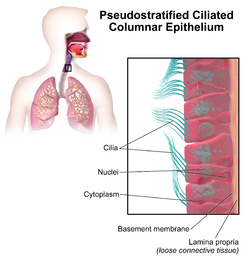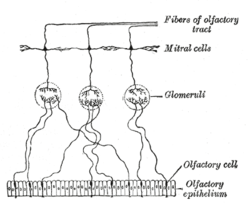Epithelium is one of the four basic types of animal tissue, along with connective tissue, muscle tissue and nervous tissue. Epithelial tissues line the cavities and surfaces of structures throughout the body. Many glands are made up of epithelial cells. Functions of epithelial cells include secretion, selective absorption, protection, transcellular transport and detection of sensation. In Greek á¼Ï€Î¯ (epi) means "on" or "upon", and θηλή (thÄ"lÄ") means "nipple". It is so called because the term was originally used to describe the translucent covering of small "nipples" of tissue on the lip.
Epithelial layers contain no blood vessels, so they must receive nourishment via diffusion of substances from the underlying connective tissue, through the basement membrane.
Classification
In general, tissues are classified by the morphology of their cells, and the number of layers they are composed of. Epithelial tissue that is only one cell thick is known as simple epithelium. If it is two or more cells thick, it is known as stratified epithelium. However, when taller simple epithelial cells (see columnar, below) are viewed in cross section with several nuclei appearing at different heights, they can be confused with stratified epithelia. This kind of epithelium is therefore described as "pseudostratified" epithelium.
There are three principal morphologies associated with epithelial cells:
- Squamous epithelium has cells that are wider than they are tall (flat and scale-like).
- Cuboidal epithelium has cells whose height and width are approximately the same (cube shaped).
- Columnar epithelium has cells taller than they are wide (column-shaped). In addition, the morphology of the cells in transitional epithelium may vary from squamous to cuboidal, depending on the amount of tension on the epithelium.
Simple epithelium
Simple epithelium is one cell thick; that is, every cell is in direct contact with the underlying basement membrane. In general, it is found where absorption and filtration occur. The thinness of the epithelial barrier facilitates these processes.
In general, simple epithelial tissues are classified by the shape of their cells. The four major classes of simple epithelium are: (1) simple squamous; (2) simple cuboidal; (3) simple columnar; (4) pseudostratified.
- (1) simple squamous; which is found lining areas where passive diffusion of gases occur. e.g. walls of capillaries, linings of the pericardial, pleural,and peritoneal cavities, as well as the linings of the alveoli of the lungs.
- (2) simple cuboidal: these cells may have secretory, absorptive, or excretory functions. examples include small collecting ducts of kidney,pancreas and salivary gland.
- (3) simple columnar; found in areas with extremely high secretive (as in wall of the stomach), or absorptive (as in small intestine) areas. they possess cellular extensions (e.g. microvilli in the small intestine, or cilia found almost exclusively in the female reproductive tract).
- (4) pseudostratified epithelia; they are also called respiratory epithelium. this is due to their almost exclusive confinement to the larger respiratory airways i.e. the nasal cavity, trachea, bronchi e.t.c
Stratified epithelium
Stratified epithelium differs from simple epithelium in that it is multilayered. It is therefore found where body linings have to withstand mechanical or chemical insult such that layers can be abraded and lost without exposing subepithelial layers. Cells flatten as the layers become more apical, though in their most basal layers the cells can be squamous, cuboidal or columnar.
Stratified epithelia (of columnar, cuboidal or squamous type) can have the following specializations:
Structure

Cells of epithelial tissue are tightly packed and form a continuous sheet. They have almost no intercellular spaces. All epithelia is usually separated from underlying tissues by an extra cellular fibrous basement membrane. The lining of the mouth, lung alveoli and kidney tubules all are made of epithelial tissue. The lining of the blood and lymphatic vessels are of a specialised form of epithelium called endothelium.
Location
Epithelium lines both the outside (skin) and the inside cavities and lumen of bodies. The outermost layer of our skin is composed of dead stratified squamous, keratinized epithelial cells.
Tissues that line the inside of the mouth, the esophagus and part of the rectum are composed of nonkeratinized stratified squamous epithelium. Other surfaces that separate body cavities from the outside environment are lined by simple squamous, columnar, or pseudostratified epithelial cells. Other epithelial cells line the insides of the lungs, the gastrointestinal tract, the reproductive and urinary tracts, and make up the exocrine and endocrine glands. The outer surface of the cornea is covered with fast-growing, easily regenerated epithelial cells. Endothelium (the inner lining of blood vessels, the heart, and lymphatic vessels) is a specialized form of epithelium. Another type, mesothelium, forms the walls of the pericardium, pleurae, and peritoneum.
Basement membrane
Epithelial tissue rests on a basement membrane, which acts as a scaffolding on which epithelium can grow and regenerate after injuries. Epithelial tissue is innervated, but avascular. This epithelial tissue must be nourished by substances diffusing from the blood vessels in the underlying tissue, but they don't have their own blood supply. The basement membrane acts as a selectively permeable membrane that determines which substances will be able to enter the epithelium.
Cell junctions
Cell junctions are especially abundant in epithelial tissues. They consist of protein complexes and provide contact between neighbouring cells, between a cell and the extracellular matrix, or they build up the paracellular barrier of epithelia and control the paracellular transport.
Cell junctions are the contact points between plasma membrane and tissue cells. There are mainly 5 different types of cell junctions: tight junctions, adherens junctions, desmosomes, hemidesmosomes, and gap junctions. Tight junctions are a pair of trans-membrane protein fused on outer plasma membrane. Adherens junctions are a plaque (protein layer on the inside plasma membrane) which attaches both cells' microfilaments. Desmosomes attach to the microfilaments of cytoskeleton made up of keratin protein. Hemidesmosomes resemble desmosomes on a section. They are made up of the integrin (a transmembrane protein) instead of cadherin. They attach the epithelial cell to the basement membrane. Gap junctions connect the cytoplasm of two cells and are made up of proteins called connexins (six of which come together to make a connexon).
Development
Epithelial tissues are derived from all of the embryological germ layers:
- from ectoderm (e.g., the epidermis);
- from endoderm (e.g., the lining of the gastrointestinal tract);
- from mesoderm (e.g., the inner linings of body cavities).
However, it is important to note that pathologists do not consider endothelium and mesothelium (both derived from mesoderm) to be true epithelium. This is because such tissues present very different pathology. For that reason, pathologists label cancers in endothelium and mesothelium sarcomas, whereas true epithelial cancers are called carcinomas. Also, the filaments that support these mesoderm-derived tissues are very distinct. Outside of the field of pathology, it is, in general, accepted that the epithelium arises from all three germ layers.
Function

The primary functions of epithelial tissues are: (1) to protect the tissues that lie beneath it from radiation, desiccation, toxins, invasion by pathogens, and physical trauma; (2) the regulation and exchange of chemicals between the underlying tissues and a body cavity; (3) the secretion of hormones into the blood vascular system, and/or the secretion of sweat, mucus, enzymes, and other products that are delivered by ducts; (4) to provide sensation.
Secretory epithelia
Glands are formed from the invagination/infolding of epithelium and subsequent growth in the underlying connective tissue. There are two major classifications of glands: endocrine glands and exocrine glands. Endocrine glands secrete their product into the extracellular space where it is rapidly taken up by the blood vascular system. Exocrine glands secrete their products into a duct that then delivers the product to the lumen of an organ or onto the free surface of the epithelium.
In arthropods, the integument, or external "skin", consists of a single layer of epithelial ectoderm from which arises the cuticle, an outer covering of chitin the rigidity of which varies as per its chemical composition.
Sensing the extracellular environment
"Some epithelial cells are ciliated, and they commonly exist as a sheet of polarised cells forming a tube or tubule with cilia projecting into the lumen." Primary cilia on epithelial cells provide chemosensation, thermosensation, and mechanosensation of the extracellular environment by playing "a sensory role mediating specific signalling cues, including soluble factors in the external cell environment, a secretory role in which a soluble protein is released to have an effect downstream of the fluid flow, and mediation of fluid flow if the cilia are motile."
Clinical significance

Classification
Epithelium grown in culture can be identified by examining its morphological characteristics. Epithelial cells tend to cluster together, and have a "characteristic tight pavementlike appearance". But this is not always the case, such as when the cells are derived from a tumor. In these cases, it is often necessary to use certain biochemical markers to make a positive identification. The intermediate filament proteins in the cytokeratin group are almost exclusively found in epithelial cells, and so are often used for this purpose.
Additional images

See also

- Blastula
- Gastrulation
- Skin cancer
References

Bibliography
- Freshney, R.I. (2002). "Introduction". In Freshney, R. Ian; Freshney, Mary. Culture of epithelial cells. John Wiley & Sons. ISBNÂ 978-0-471-40121-6.Â
- van Lommel, Alfons T.L. (2002). From cells to organs: a histology textbook and atlas. Springer. ISBNÂ 978-1-4020-7257-4.Â
Further reading

- Green H (September 2008). "The birth of therapy with cultured cells". BioEssays 30 (9): 897â€"903. doi:10.1002/bies.20797. PMID 18693268.Â
- Kefalides, Nicholas A.; Borel, Jacques P., eds. (2005). Basement membranes: cell and molecular biology. Gulf Professional Publishing. ISBNÂ 978-0-12-153356-4.Â
- Nagpal R; Patel A; Gibson MC (March 2008). "Epithelial topology". BioEssays 30 (3): 260â€"6. doi:10.1002/bies.20722. PMID 18293365.Â
- Yamaguchi Y; Brenner M; Hearing VJ (September 2007). "The regulation of skin pigmentation" (REVIEW). J. Biol. Chem. 282 (38): 27557â€"61. doi:10.1074/jbc.R700026200. PMID 17635904.Â

